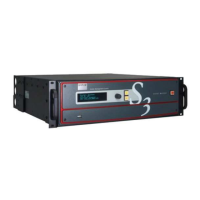R5905948 /12 Event Master Devices274
7.1 Setup Prerequisites
Prerequisites
Before starting to set up your Event Master series processor, please review the following prerequisites:
• Ensure that you are familiar with the Event Master devices, including system control means and features.
For details, please refer to the chapter “General”, page 25.
• Ensure that you are familiar with front panel menus of the Event Master processors. For details on all
menus, please refer to the chapter“Front Panel Menu orientation”, page 83
• Ensure that you are familiar with front panel menus and Event Master Toolset Software. For details on
Event Master Toolset Software, please refer to the chapter“EM GUI orientation”, page 103
• Ensure that the unit is physically secured inside a rack or is placed on a flat surface with a stable support. If
the unit is installed in a rack, it is mandatory that the rear brackets are also installed. For details, please
refer to the chapter “Rack-Mount Procedure”, page 49.
• Ensure that all hardware is properly installed, and that all sources, displays and peripherals are properly
connected. For details concerning Event Master series processor connectors, please refer to the unit rear
panel description in the chapter “Rear panel”, page 55.
• Connect the AC power to the unit. If power redundancy is desired, connect power to both power plugs.
• Make sure that the Event Master series processor is connected to the Ethernet local network in order to
communicate with the PC where the control software is installed.
7.2 System setup sequence
Set up from A to Z
This section provides a top level view of the entire Event Master series processor setup procedure, plus links
to each individual sequence.
For the optimum Event Master series processor setup, it is recommended that you follow all
procedures in the order outlined below.
Set up from A to Z
1. Power up and Status check. For more information refer to the section “Power up and Status check”, page
275.
2. Return to factory default. For more information refer to the section “Return to factory default”, page 276.
3. Communication setup allows setup to the Ethernet settings. For more information refer to the section
“Communication setup”, page 276.
4. Restoring the system procedure restores the system to a previously saved configuration from a USB drive.
For more information refer to the section “Restoring the system”, page 277.
5. User preference setup is used to set a variety of important user preferences. For more information refer to
the section “User preference setup”, page 278.
6. Saving the setup procedure saves all system setup parameters. For more information refer to the section
“Saving the setup”, page 278.
7. Backing up the system procedure backs up your system configuration to a USB drive. For more information
refer to the section “Backing up the system”, page 279.
8. Configuring Menu > Initial Setup. For more information refer to the section “Configuration Menu > Initial
Setup ”, page 279.
9. Configuring Menu > Add Background(s). For more information refer to the section “Configuration Menu >
Add Background(s)”, page 280.
10. Configuring Menu > Add Inputs. For more information refer to the section “Configuration Menu > Add
Inputs”, page 281.
11. Configuring Menu > Add Outputs. For more information refer to the section “Configuration Menu > Add
Outputs”, page 282.
System Setup

